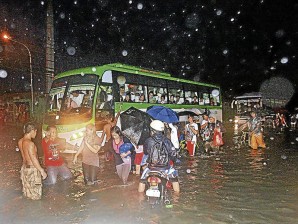MMDA, Metro Manila officials start preparing for rainy season

Trapped commuters sit it out on idled buses or brave the flash flood in Caloocan City, one of the many areas in Metro Manila that went underwater in a matter of hours on June 23, 2011. The Metropolitan Manila Development Authority on Sunday, May 13, 2012, said it has started distributing tents and generators for temporary evacuation centers in preparation for the onset of the rainy season. INQUIRER PHOTO/RAFFY LERMA
MANILA, Philippines—In preparation for the onset of the rainy season, the Metropolitan Manila Development Authority (MMDA) has started the distribution of multipurpose tents and generators for temporary evacuation centers or remote command posts to be set up in the event of a disaster or calamity.
In a statement, MMDA Chairman Francis Tolentino said some 170 tents and generators would be distributed equally among the 17 local government units (LGUs) in Metro Manila.
“This is the start of our effort to help LGUs improve their disaster response and preparedness programs. They can use these multipurpose tents as command and control centers, tent hospitals and temporary shelters,” he added.
Each tent has a floor area of 35 square meters and can shelter up to 34 persons with enough space left over for medicine and other rescue paraphernalia. With a power supply coming from the generator, the tent can function as a command and coordination center where disaster response can be mapped out efficiently.
The tents can also serve as first-aid stations, temporary classrooms or field clinics where victims of disasters or calamities can be given immediate attention, according to Tolentino.
Article continues after this advertisementThe cities of San Juan, Muntinlupa and Malabon have already received their share of the disaster preparedness equipment while the town of
Article continues after this advertisementPateros and Taguig City will get theirs on Monday.
Skills enhancement
In a related development, Tolentino said the MMDA would continue enhancing the disaster response skills of barangays (villages) in Metro Manila in line with Oplan Metro Yakal, the agency’s disaster preparedness program.
Right now, around 1,000 barangay officials and volunteers in each local government unit are undergoing training, the MMDA chairman said.
“More than providing them with necessary gear and equipment, it is more important that everyone knows what to do and where to go when a calamity strikes,” Tolentino added.
The disaster response training includes courses on basic search and rescue, debris clearing, emergency communication and transport, traffic management and control, and relief and rehabilitation services, among other areas.